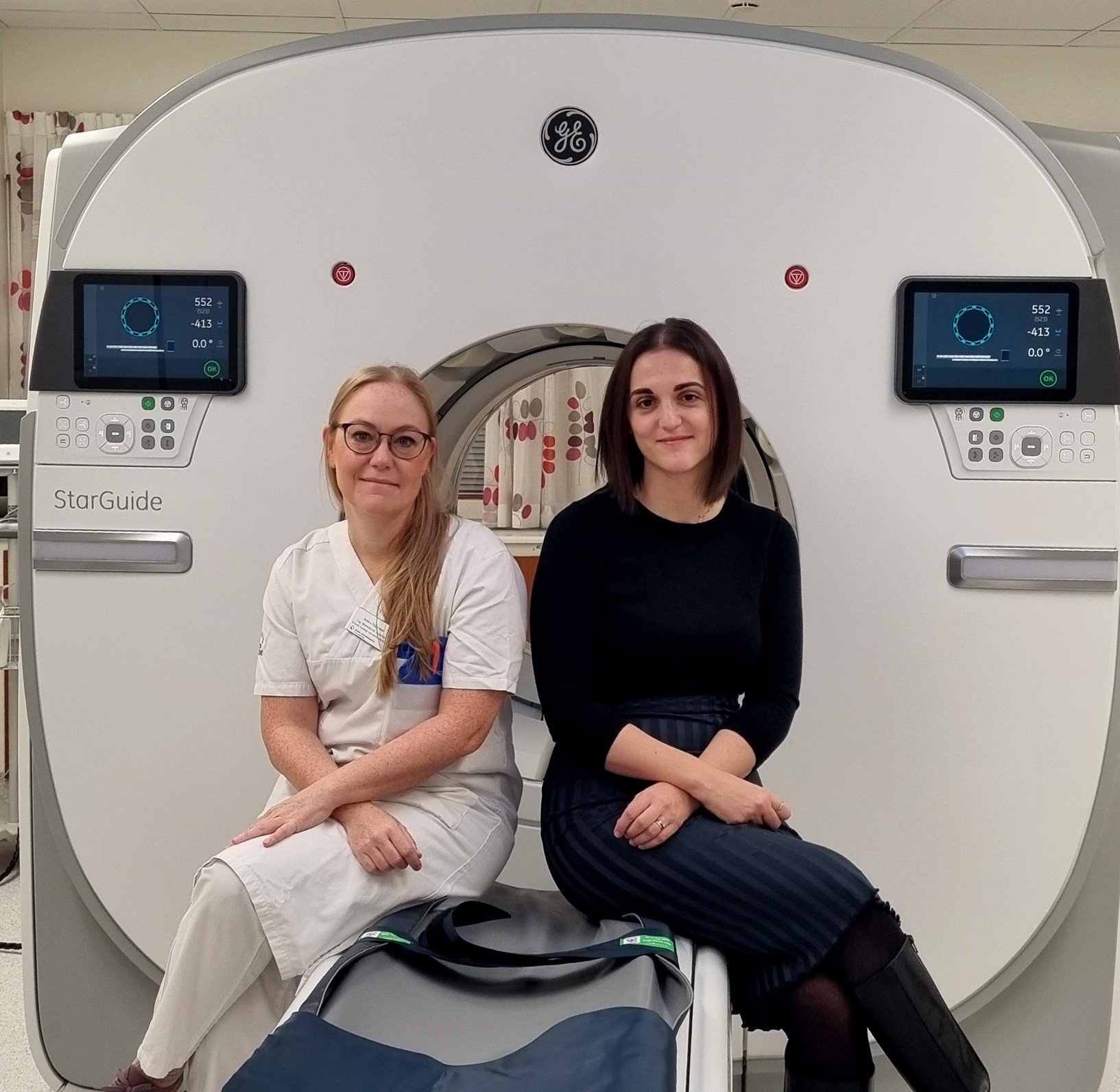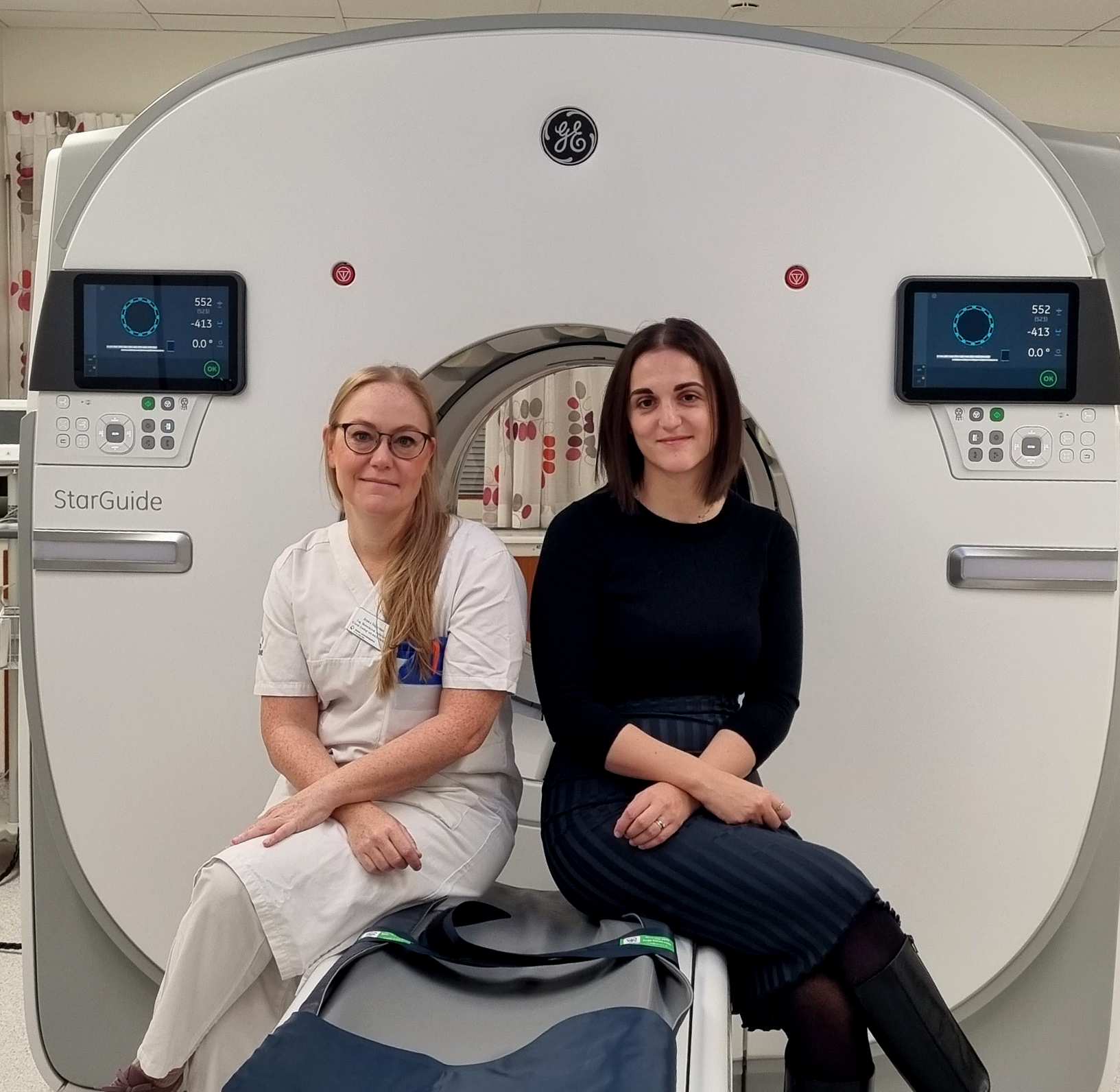Skåne University Hospital is the first hospital in Sweden to acquire GE HealthCare’s most advanced SPECT/CT scanner, the StarGuide system. Technologist Jessica Hagerman and Medical Physicist Irma Ceric Andelius from the department of Imaging and Physiology share their experiences with this new digital 3D SPECT/CT system.
Skåne University Hospital in Southern Sweden is the third largest hospital in the Nordics, with a total of 12,000 employees representing over 100 different professions. The hospital’s two main wards, located in the city of Malmö and in the smaller university town of Lund, offer a full range of highly specialised healthcare services. The hospital group is Sweden’s leading hospital on several areas, i.e., on coronary angiography and percutaneous coronary intervention and cardiothoracic surgery.
Each day, the hospital’s radiological and diagnostic centres perform in total more than 1000 examinations, often involving SPECT/CT scanning. In early 2022, it was time to renew and upgrade some of the existing systems and following a standard evaluation procedure and procurement process it was decided to invest in the StarGuide system; GE Healthcare’s most advanced SPECT/CT scanner featuring advanced Cadmium Zinc Telluride (CZT) technology and designed to usher in a new era of discovery for Nuclear Medicine[1].
Technologist Jessica Hagerman and Medical Physicist Irma Ceric Andelius from the department of Imaging and Physiology at Skåne University Hospital with their new digital 3D SPECT/CT, StarGuide – the first hospital in Sweden to acquire the SPECT/CT scanner.
Skåne University Hospital is the first hospital in Sweden to acquire the StarGuide system. Six months on, Technologist Jessica Hagerman and Medical Physicist Irma Ceric Andelius from the department of Imaging and Physiology at the Lund ward are happy with the array of new features offered by the StarGuide.
“(…) it’s all about the sum and combination of new and smarter features and functionality. We find the StarGuide very user friendly to operate. That is what enables us to retrieve better scanning data and to get it faster, and because of this we are able to examine more patients on a daily basis.”
Jessica Hagerman, Technologist Skåne University Hospital
“StarGuide allows us to work more efficiently and intelligently”
“In a nutshell we have found so far that it’s all about the sum and combination of new and smarter features and functionality. We find the StarGuide very user friendly to operate. This enables us to retrieve better scanning data, faster, and because of this we are able to examine more patients on a daily basis. StarGuide allows us to work more efficiently and intelligently,” says Jessica Hagerman. Irma Ceric Andelius adds:
”It really only took us about two months to implement the StarGuide – to install it, to learn how to use it, and to begin exploiting its full potential in our department. The fast implementation and validation of our most common examinations was possible due to a close collaboration with GE HealthCare’s engineering team in Haifa; meeting with them on a regular basis where we discuss challenges, image quality, the structure of the algorithms and potential improvements is appreciated.”
“We have learned to exploit features such as the SmartConsole that allows us to optimize image quality and scan time remotely. The combination of the new detector architecture with improved algorithms, paves the way for more informed decisions and, at the end of the day, better results for the patient. We’re working on utilizing the full potential of the system’s image quality,” says Irma Ceric Andelius.
”The fast implementation and validation of our most common examinations is much due to a close collaboration with GE HealthCare’s engineering team in Haifa (…) We have learned to exploit features such as the SmartConsole that allows us to optimize image quality and scan time remote.”
Irma Ceric Andelius, Medical Physicist Skåne University Hospital
Irma and Jessica also point out how the 3D whole body acquisition –enables a more effective and optimized scanning process, because of the larger amount of data from one acquisition. It has been insightful to learn about the scanner’s geometry related to the build of the StarGuide and then how to implement that for optimal acquisition.
12 slim detectors have resulted in less patient discomfort
The scanner’s digital detectors are designed to propel SPECT imaging to new heights in performance by maximizing the amount of information. In total, 12 slim detectors orbit the body as closely as possible, resulting in a high-resolution scan and minimization of patient time on the camera. The CZT detector technology features a higher count rate over conventional detector technologies, in fact StarGuide’s intrinsic count rate is greater than 700 kcnts/second with no detector saturation or resulting dead time[2]. This is pivotal to minimizing the patient’s exposure to SPECT’s radioactive processes[3].
StarGuide also includes the Swift Plan workflow, which is designed to simplify clinician interactions with a scanner. Thanks to the Optical Scout, the system quickly and accurately creates a 3D optical scan of the body habitus, generating a topographic map of the patient for fast proximity positioning of each detector and rapid transition between imaging positions. This is helping minimizing patient’s time on the camera and reducing dependency of image quality on users’ expertise as well users’ exposure to patients injected dose[4].
“The patient experience itself has proven to be very positive. There are simply fewer patients who experience discomfort or outright claustrophobia, which can otherwise often be a challenge.”
Jessica Hagerman, Technologist Skåne University Hospital
“The patient experience itself has proven to be very positive. There are simply fewer patients who experience discomfort or outright claustrophobia, which can otherwise often be a challenge. We were not expecting this, so this is certainly a nice advantage that has to do with the comparatively slim detectors used in StarGuide,” says Jessica Hagerman.
“For us, StarGuide has been an improvement, and we are also looking forward to the software enabled features that are currently being developed that will make this an even more valuable tool in our daily work,” states Irma Ceric Andelius.
[1]StarGuide product webpage (JB02713XX)
[2] StarGuide product webpage(JB02713XX)
[3] StarGuide product webpage (JB02713XX)
[4] StarGuide digital SPECT/CT datasheet


